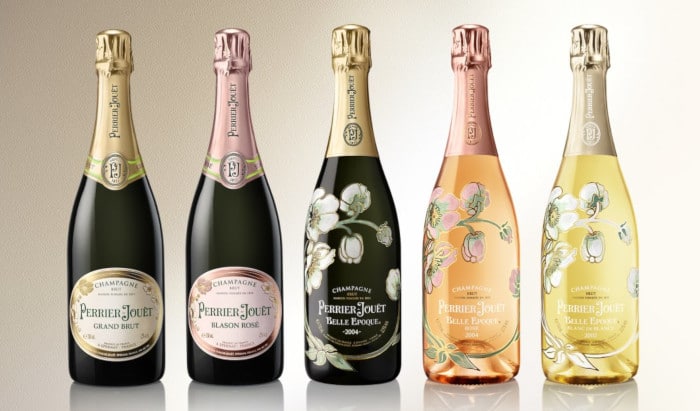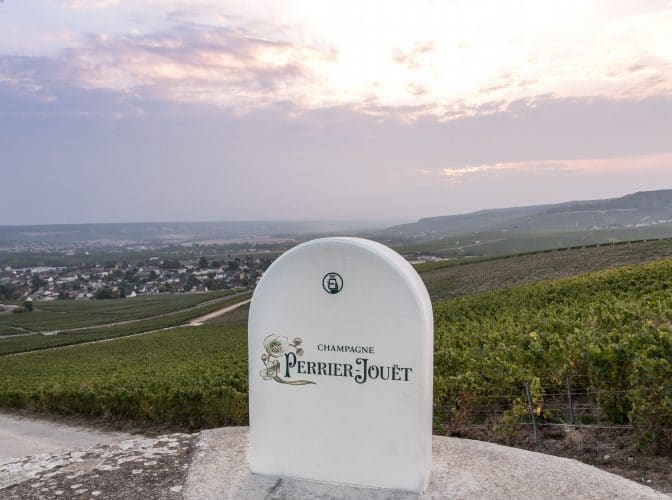
There has been a real buzz in Champagne over recent years, with many producers looking for ways to innovate; whether for a short-term marketing bounce or for long-term strategic advantage. Finding ways to pitch against tough competition, especially when facing an increasingly sophisticated consumer market, has transformed age-old Champagne Houses into savvy, modern-day enterprises that are evolving with the times.

It’s a trend that 200 year-old Champagne House, Perrier-Jouët, has handled with an uncommon air of grace and remarkable ability to hold true to its foundational style and vision, despite being Champagne’s 10th largest House, at three million bottles annual production.
Much of this appears to be due to the stewardship of Perrier-Jouët’s Chef de Cave (Cellar Master), Hervé Deschamps, a man I was privileged to meet on his recent trip to Australia. Herve’s visit to Australia coincides with the Australian summer release of Perrier-Jouët’s Belle Epoque Blanc de Blancs 2004, including a very limited release of a specially designed bottle, and pre-dates the new year release of Belle Epoque 2008.
By all accounts, Hervé is a traditionalist in the ever ambitious world of champagne. He sees himself as a kind of custodian of the Perrier-Jouët way, famous for its chardonnay-driven, botanical style of spring florals and chalky minerality. Much like the style of the House he represents, Hervé is a quietly considered, gracious and gentle man. It was easy to see, after spending a few hours of tasting with him, that his whole demeanor and philosophical approach to champagne is in harmony with the cuvées he creates.
Hervé is only the seventh Perrier-Jouët Cellar Master in the House’s history, having commenced the role in 1993. In the ten years prior to this, he garnered knowledge of the House’s unique style under the tutelage of his predecessor. This rare amalgam, where the time-honoured vision and legacy of the House aligns to its modern-day custodian, has ensured the House style remains true to itself and to those who sip its divine cuvées. It is, almost certainly, a style that leaves an impression on almost all who taste it.

The unforgettable white and yellow flower aromas produce a literal champagne bouquet coming together with mineral precision to form a perfect balance. It’s all about the beauty and harmony of nature. It is also a style synonymous with the visual branding of the House, one of floral decadence of the art nouveau era, symbolised on its Belle Epoque bottles by white Japanese anemone flowers.
Read more in the book “Champagne [Boxed Book & Map Set]: The Essential Guide to the Wines, Producers, and Terroirs of the Iconic Region“
Perrier-Jouët has done well to honour its heritage by taking a relatively conservative marketing approach. It is only occasionally lifted by a limited release cuvée inspired by nature and the seasons, a specially designed bottle, or an artistic exhibition celebrating its champagnes. Recent examples include the limited edition Belle Epoque Edition Automne 2005 and Belle Epoque Blanc de Blancs 2004 produced in a limited edition bottle designed by Japanese artist Ritsue Mishima (of which only 72 are available in Australia). It’s refreshingly authentic to who they are and a testament to the man behind their mini-masterpieces.
As a chardonnay House, Perrier-Jouët source most of its grapes from the Côte des Blancs, seeking out fruit from the chalk-rich soils of Cramant, Avize and Chouilly, as well as up to 70 villages across the Champagne region. They are privileged to own around 65 hectares of vines, or 25 per cent of their production needs, including some coveted mid-slope vines in Cramant which impart a delightful sense of creaminess. Pinot noir comes from Verzy, Verzenay, Aÿ, Mailly, Avenay-Val-d’Or and Les Riceys whilst meunier is sourced from Venteuil, Damery, Dizy and Vincelles. Red grapes are selected for their aromas and subtleties, rather than power and structure.
Floral expression and mineral precision is the focus of the vinification process which is achieved using only stainless steel tanks, maintained at 18-20 degrees. “It’s best to have a quick fermentation and then close the tanks as quickly as possible,” says Hervé. “It helps to preserve the freshness in our aromas.”
Full malolactic fermentation is also enacted to tame chardonnay’s edge and to complement the House’s softer style. “We’ve been working with the CIVC to develop a new strain of bacteria to achieve full malolactic fermentation,” says Hervé. “Malolactic fermentation wasn’t being fully completed, so we needed to find a way of making it finish its job.”

One of Perrier-Jouët’s other distinguishing features is its very fine, soft bead, adding to its elegance and creaminess. Rather than being bottled under lower pressure, Hervé says that long ageing is the key to reducing aggressiveness in Belle Epoque.
And when it comes to the emerging trend to grow grapes bio-dynamically, Hervé is less than enthusiastic. “No,” he says. “Perhaps organics, but not bio-dynamics. The key is to not destroy ‘life’ on the farms because after 20 years, it becomes a desert.” It’s a sensible approach that sits half-way between the current trend and commercial pragmatism.
Of all the excellent vintages that have occurred over recent years, Hervé singles out 1998 and 2002 as the ones that get him truly excited, but he also cannot wait to see what becomes of Belle Epoque 2008. Destined for Australia’s shores in February 2017, Belle Epoque 2008 is based on a classic and truly excellent vintage year for Champagne. To Hervé, it will impart more elegance than 2007 and will be the best Belle Epoque since 1982. A big claim. Released to Australia in a small allocation, it will no doubt be hotly acquired by enthusiasts of Perrier-Jouët.
It has been two years since Hervé last visited Australia, a busy life of leading production of one of the largest Champagne Houses involves almost never-ending travel to educate audiences and promote its products. Much has changed on the Australian champagne landscape in this time with a flurry of new entrants and increased focus on marketing activities. But in all of this, Perrier-Jouët has remained true to itself and ever constant in its purpose. To me, that’s what makes it even more beautiful.
Perrier-Jouët’s summer release of the Belle Epoque Blanc de Blancs 2004 (Ritsue Mishima bottle) is available at selected retailers across Australia.
The following notes of Perrier-Jouët cuvées were taken during my tasting with Hervé.
Perrier-Jouët Grand Brut Non-Vintage
A blend of 40% pinot noir, 40% meunier and 20% chardonnay. Includes up to 20% reserve wines. Bottles are aged for 2.5 years and given a dosage of 9g/L.
Glass – The glass is pale lemon, supported by a small bead and good mousse.
Nose – The nose is youthful and fresh with classic Perrier-Jouët notes of acacia and orange blossom as well as juicy red apples, pear and a hint of lemon zest.
Palate – The palate is noticeably soft and rounded, led by obvious signs of meunier (soft and fleshy red stone fruits) but given a subtle structure from pinot noir. There are obvious signs of malolactic fermentation but these seem to work harmoniously with the intended style; one of smoothness, elegance and lightness. There are notes of grapefruit, Danish pastries, a touch of toffee and green apple. It is deliciously mouth-filling, in a delicate way, and leads to a medium finish that is smooth and silky.
Perrier-Jouët Belle Époque 2007
A blend of 50% chardonnay, 45% pinot noir and 5% meunier. Bottles are aged for six years and given a dosage of 9g/L.
Glass – The glass is pale gold and offers a very fine bead.
Nose – The nose is still quite youthful and energetic but displays some developing notes in a complex tapestry of citrus peel, white flowers (honeysuckle), red berries, pear, brioche and chalky minerality.
Palate – The palate is a delight, full of creamy bubbles manifesting alongside medium levels of acidity. The body is medium-plus and produces intense flavours of white stone fruits, pastries, caramel and a hint of minerality. It leads to a long finish that is dry and very well balanced. A beautiful champagne that is drinking well now but will do well to age another few years.
Perrier-Jouët Belle Époque 2002 (disgorged in 2009)
A blend of 50% chardonnay, 45% pinot noir and 5% meunier. Bottles are aged for six years and given a dosage of 9g/L.
Glass – The glass is deep gold and produces a super-fine bead.
Nose – The nose is pronounced with developed notes of lemon meringue, crème brulee and candied orange peel. A real treat!
Palate – The palate is full-bodied, developed and rich, yet remarkably fresh with excellent acidity. It stands up as a good example of bottle ageing a fine vintage in good storage conditions. Flavours abound with smokey tea, orange peel, toast, cut grass, wet hay and a ‘licking the stones’ minerality. The intensity of flavours are restrained by the elegance of the chardonnay, and leads to a long finish.
Perrier-Jouët Blason Rosé (based on the 2012 vintage)
A blend of 50% pinot noir, 25% meunier and 25% chardonnay. It includes 15% red wine from the Marne Valley.
Glass – The glass is medium salmon with a tinge of copper.
Nose – On the nose, it is youthful and lively. There are notes of strawberries and cream, sherbet and light pastries.
Palate – The palate is fresh and youthful, producing medium acidity and notes of raspberries, strawberries and mandarin peel tempered by classic pinot noir pepper notes. Adding complexity, there is a little caramel and stone-like minerality. It’s a delightful rosé that is gentle and fresh. It leads to a dry and medium finish.
